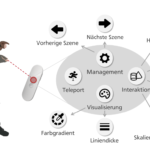An experience report on the Master’s lecture „Environmental Planning“ at the Department of Civil and Environmental Engineering by Dr. Stefan Scheiner
What is Mentimeter?
Mentimeter is a live voting tool (→ for comparing different systems [information in German only] ) that is chargeable and can also be used in a free version (→ link to the tool description [information in German only]). The elements used in my session are available in the free version.
Classification of the course
The „Environmental planning“ course I conducted is a lecture (with accompanying exercise) for Master’s students who are mostly studying for an engineering degree. Usually between 70 and 100 students are registered, and about half of the students attend the tutorials.
What is special about the event is that students have to work more with social science research results than they are used to from the „core subjects“ of their courses. In addition to building up technical competencies in terms of content, one of the learning objectives of the event is that students can present and discuss social science findings that they have developed themselves.
Against this background of the desired learning objective, the lecture is intentionally oriented towards interaction so that students are able to participate in the lecture and to discuss with each other as well as with the tutor.
How was Mentimeter used and why?
I used Mentimeter several times in the tutorial to support the outlined orientation to interaction. In concrete terms, the didactic functions can be further differentiated. In the following, I present my experiences with the tool using the individual didactic functions as an example. In each case, I deal briefly with my motives and the didactic integration in the lecture.
Get to know the students and raise awareness of the nature of the event
One particular challenge of the event is that in the beginning, students are not really able to assess what specifically is expected of their performance. The handling of social science research results differs from the study of engineering subjects, and there is simply no experience of what is important there and how to handle it.
The following query, which students must complete before we start the first session, takes up any prior experience and addresses any conflict (typical for this event) between engineering and social science approaches with regard to the contribution of technical innovations for solving environmental problems (cf. fig. 1). Any linguistic uncertainties are also addressed.
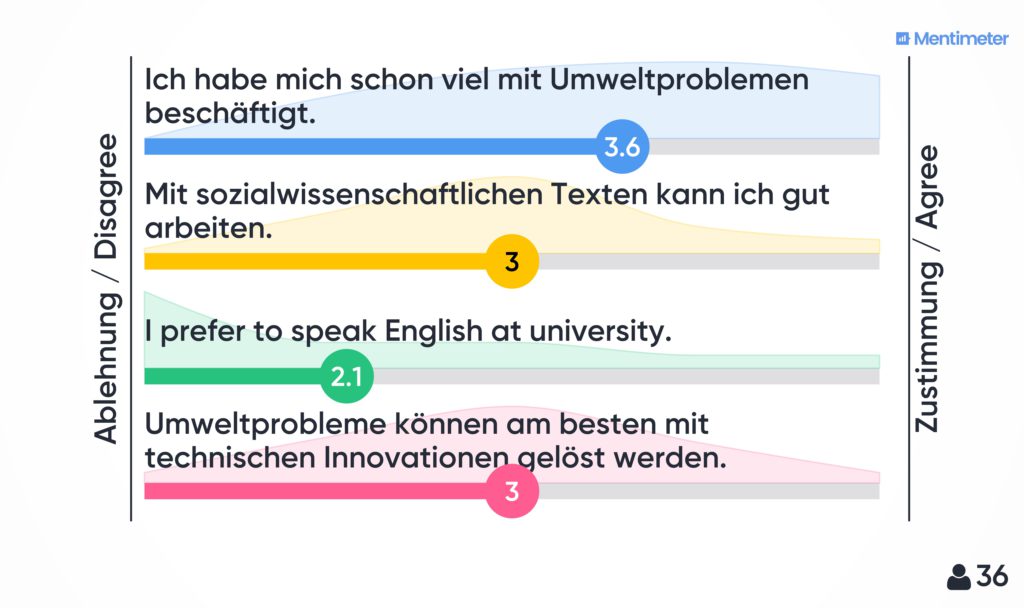
The online survey is integrated from a conversation in the first lecture on the survey results in the first session. This also serves to discuss the character of the lecture and certain rules (discuss with respect, let others finish speaking etc.; contributions in English are allowed).
Regardless of the specific commitment to the event, the short survey before we start gives me an impression of the students and provides me with initial thoughts on potentials or challenges in the event. Mentimeter is the appropriate tool for me because participation in the survey can easily be organised even before the event starts (i.e. registration is not required, a simple link is sufficient) and the presentation is appealing.
Create curiosity and await the comparison of expectations
An event also thrives on students being curious about what is ahead of them, and actively working on the topic. One pleasant way to implement this important learning principle [information in German only] is that students can start by thinking about what important topics or questions in the subject could be. Trying to structure a topic in advance creates an initial basic framework and makes you curious to see whether you are right, and what might need to be added.
Over the course of the lecture, this was carried out both associatively and analytically. Both were implemented in Mentimeter with survey types.
Associative access was made through the task of naming three terms that spring to mind on the subject of environmental protection. This is implemented in Mentimeter with the question type „Word cloud“. As the result, the students jointly created a word cloud (cf. fig. 2) that provides a helpful starting point for the presentation of the topics and the balance of expectations for the event. This assignment was combined with a padlet in which the terms and topics were structured based on that.
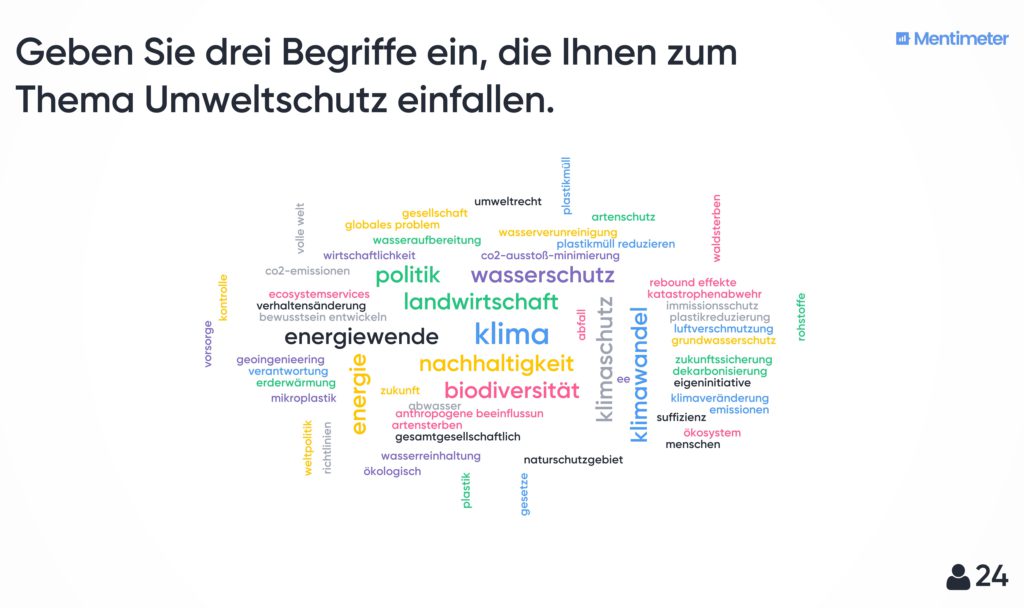
The analytical approach is to encourage the independent processing of typical questions (e.g. in the form of a paper / homework), and serves at the same time as the first draft for the structuring of the technical discussions. The students were given a decision-making problem and asked about the higher-level questions that they had to ask themselves in order to discuss and answer the decision-making problem (see fig. 3).
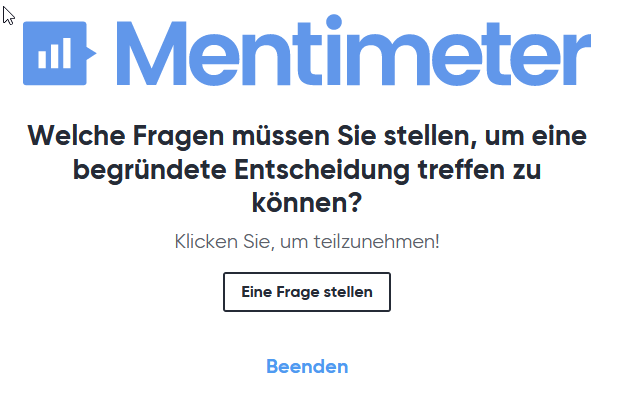
The Mentimeter survey type „Q&A“ (question and answer) was slightly misappropriated for this purpose. In itself, the Q&A tool is designed to be able to collect questions continuously and then answer them during the event. In this case, the answer function was omitted, and the option of entering one’s own question and marking the other questions as „important“ („votes“) mostly used. This provides a helpful ranking that can be called upon repeatedly in discussions and offers students support with independently processing topics (e.g. when it comes to finding a specific question for the homework). Because the tools was misappropriated slightly, it is not really feasible to present the complete presentation in the event via Mentimeter. However, there is a convenient export function, so a table could be integrated in the presentation (cf. fig. 4).
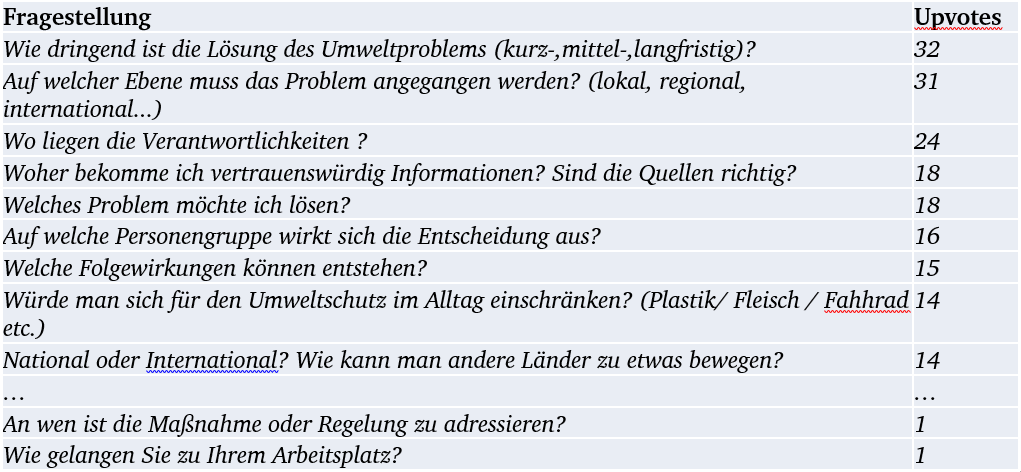
Activating prior knowledge / peer instruction
In order to not only give students an overview of the content of the lecture but to also activate their own prior knowledge (→ on the importance of activating prior knowledge [information in German only] ), the method Peer instruction according to Mazur [information in German only] with the Multiple Choice tool was implemented in Mentimeter (cf. fig. 5).
Specifically, they were asked about something that they should all have learnt at school and what would be an important basis for the further discussion of the topic in the lecture. Mentimeter provides very nice support with an appealing presentation of the voting result, and allows the right answer to be released at the right time.

Conclusion
All in all, Mentimeter has proven to be a flexible coordination tool that is easy to use both for me as the teacher and for the students. The students could participate both on their laptops and on their smartphones with no problems. A positive conclusion was also drawn in the overall view of the evaluation of the course. Without explicitly asking about the live votes, they were mentioned specifically and highlighted positively on several occasions.





